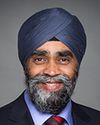Madam Chair, I am pleased to rise to take part in this important debate surrounding the main estimates of the Department of National Defence.
The Canadian Armed Forces must be ready to meet all of these challenges at all times, as well as our domestic security needs. We live in an increasingly complex and unpredictable world. The threats we face come from both traditional sources and from unexpected directions. These include failed and failing states, civil wars and regional conflicts, as well as the enduring threat of global terrorism. I am fully confident that the Canadian Armed Forces will be ready to meet these challenges.
However, it needs our help. Training and personal valour are not enough. It must also be equipped to meet the challenges of the future. This is an issue we can all agree on. All members of this chamber want a well-equipped military, and all Canadian taxpayers want us to acquire that equipment at a fair price. So I would like to say a few words about military procurement and how we will get our men and women in uniform the equipment they need to carry out their important missions.
Much has been said about the challenges in procurement—challenges that are shared by all modern militaries—and about the need to modernize the military procurement process.
Even the United States, our strongest ally and one of the most powerful military forces in the world, has been having this sort of problem for years. Some risks are inevitable. Military equipment needs to be reliable and has to be able to function in a wide variety of environments and conditions. It must also be designed to survive new threats.
When an aircraft or vehicle flees danger, the military equipment must be able to continue advancing into high-risk areas. If the equipment is not built to last, it could endanger the lives of our soldiers and jeopardize their mission. That is why military equipment is built to meet exacting standards, which makes it more costly.
As the Parliamentary Secretary to the Minister of National Defence stated earlier tonight, the department manages more than 10,000 equipment-specific contracts every year, with a total value of nearly $6 billion. This covers everything from clothing and combat boots, rations and fuel, weapons and ammunition, satellite communications systems, vehicles, ships, aircraft, pens, paper, and stationery, to the maintenance of all of this equipment. The vast majority of these 10,000 equipment contracts are completed successfully without issue. However, more remains to be done, primarily with contracts of significant magnitude.
In the past six months, the procurement process has been a preoccupation of the ministers of National Defence, Public Services and Procurement, and Innovation, Science and Economic Development. I am sure we can expect additional improvements as their work continues. The government has also taken steps already to address some of the most challenging procurement files.
First, we will ensure the Royal Canadian Air Force obtains a replacement for the CF-18 fighter fleet.
Second, we are moving forward with new ships for the navy. With the longest coastline of any nation on earth, Canada has much to gain by ensuring that its navy can protect Canadian waters. As many members know, more than 90% of the world's trade is carried by sea, so this is critical to our economic interests as well. Ships are already being built, with more to come this year and next. Arctic offshore patrol ships are currently being built at the Halifax dockyard with the first scheduled delivery to the Royal Canadian Navy planned for 2018.
Third, through various initiatives, National Defence staff is reducing the number of steps in the procurement process, while also ensuring that the process is more open and transparent to both industry and all Canadians.
Fourth, we are committed to providing the Canadian Armed Forces with consistent and predictable funding. We are maintaining current spending levels as well as planned increases, including the increase of the National Defence escalator from 2% to 3% beginning in 2017. This escalator will provide an additional $11.8 billion in funding over 10 years.
As I said earlier, most National Defence contracts are completed successfully without issue. Many of them involve the routine procurement of supplies, such as replacement parts, combat clothing, and ammunition.
Some contracts are for parts and maintenance, while others are more vital. Funding for those key contracts is essential if we want the Canadian Armed Forces to be able to fulfill their mission. Take for example, the modernization of the Halifax-class frigates. These ships are the backbone of the Royal Canadian Navy.
Under the current modernization program, sensors, weapons, and other systems are being upgraded so that they will continue to be effective against modern threats. Nine frigates have already been modernized and three others will follow. In this year's main estimates, the department is asking for some $180 million for this work, which is essential to keep our navy strong.
The main estimates also contain funding for the modernization of the CP-140 Auroras, the maritime patrol aircraft which are even now being used to provide critical intelligence and reconnaissance as part of Operation Impact. The CP-140s have conducted nearly 500 missions in Iraq, helping our members on the ground and our coalition partners. This year, almost $150 million will be spent as part of the ongoing modernization of the Aurora fleet. These upgrades will extend the life of the fleet to 2030, and improve an already impressive aircraft.
Information and intelligence are key to modern military operations, and supporting DND's main estimates will allow this long-range patrol aircraft fleet to maintain its world-class capabilities.
The last example I will mention is the modernization of the fleet of light armoured vehicles, or LAVs. These vehicles are true workhorses for the Canadian army, and have been deployed domestically and on international operations. A total of $150 million has been requested in the main estimates for this project, which is improving the LAV fleet's mobility, protection and other capabilities.
One of the ways in which the government will improve the procurement process is through the defence policy review. As announced by the Minister of National Defence, this review will take a broad, comprehensive view of the Canadian Forces. It will outline the expected role of the institution and what we want to accomplish both at home and abroad.
This has important implications for the procurement process, and from that we can determine the capabilities our military will need and how they will be employed. The policy review will give our military planners a guide that they can use to determine what capabilities they will need. We are looking forward to these results.
I know that everyone in this chamber supports our men and women in uniform. The Canadian Armed Forces is a source of national pride for Canadians from every walk of life, and I was proud to serve as an officer among their ranks. We all support our military because we know they will be there for us when we need them, and so we need to do our part as well.
By ensuring stable funding for the Canadian Armed Forces and improving defence procurement, we will ensure our military has the equipment it needs to do its important work while also valuing a national industrial base that will help to create jobs and investments and innovation and leading-edge technology, because whether they are defending our values and interests abroad or protecting the lives of our citizens at home, the men and women of the Canadian Armed Forces are the force of last resort. They cannot fail, and so, neither can we.
Could the minister provide an update on the steps he has taken to make the procurement process more effective, and to ensure that our brave men and women in uniform get the equipment they need?




